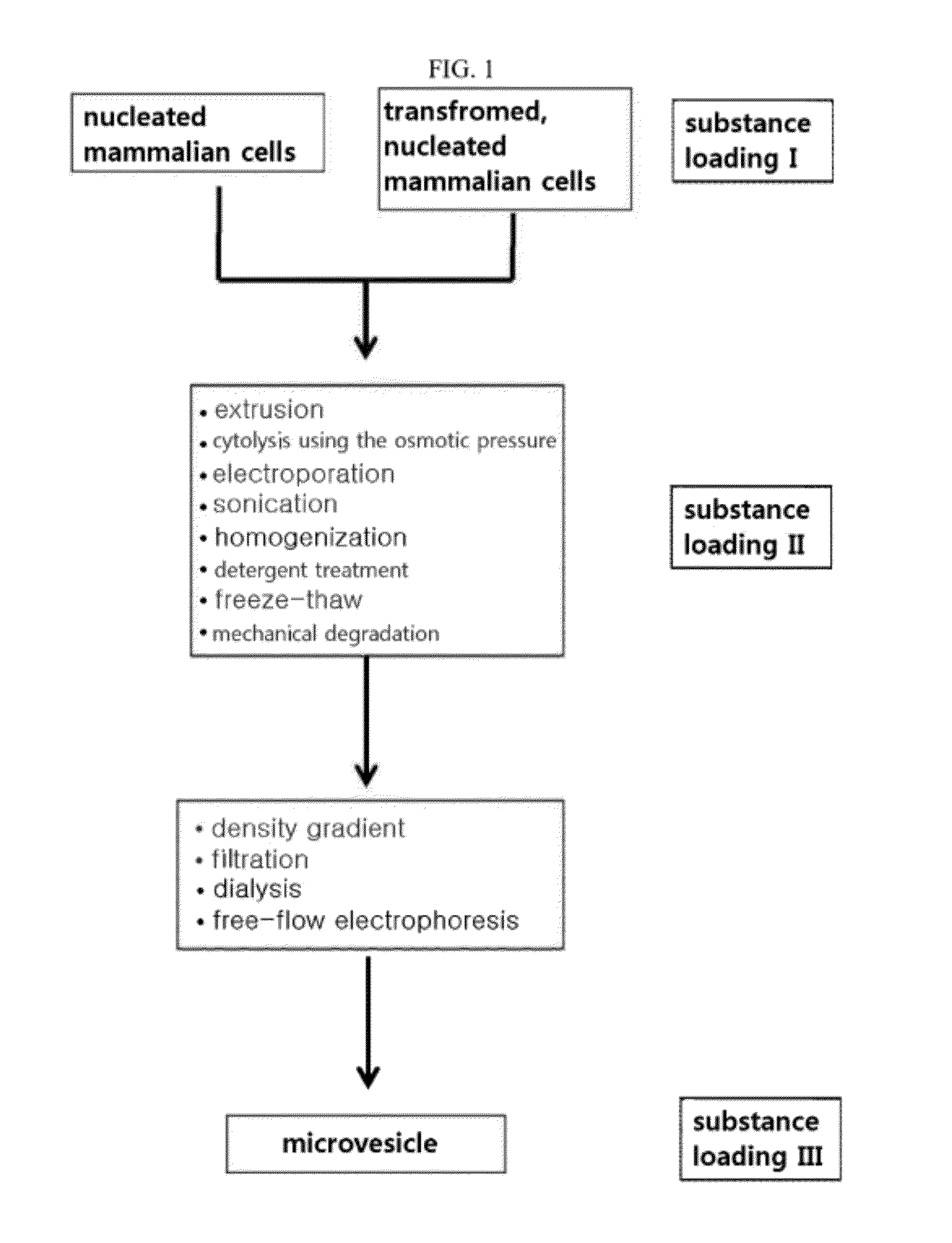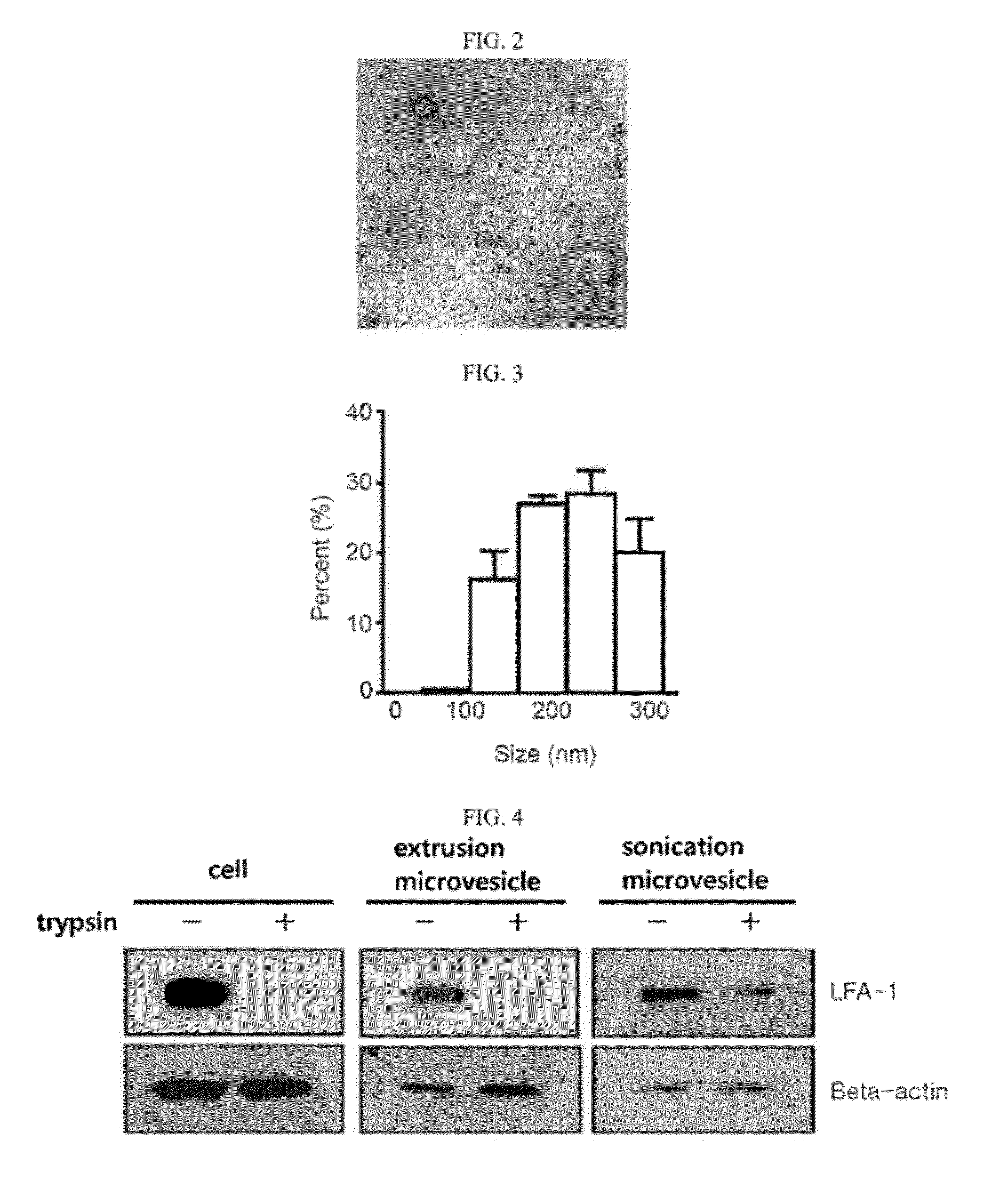Microvesicles derived from nucleated, mammalian cells and use thereof
a technology of microvesicles and mammalian cells, applied in the field of microvesicles derived from nucleated mammalian cells, can solve the problems that the stealth liposome itself cannot deliver drugs to target cells or tissues, cannot pass clinical tests and successfully commercialized, and have not yet passed clinical trials and commercialization, etc., to achieve the effect of enhancing therapeutic efficacy, reducing agony and inconvenience of cancer patients, and enhancing therapeutic efficacy
- Summary
- Abstract
- Description
- Claims
- Application Information
AI Technical Summary
Benefits of technology
Problems solved by technology
Method used
Image
Examples
example 1
Preparation of Microvesicles by Extrusion
[0186]FIG. 1 is a scheme showing a process of preparing microvesicles loaded with various substances including targeting materials, therapeutic materials and diagnostic materials from nucleated mammalian cells, whether transformed or not.
[0187]According to the procedure illustrated in the scheme of FIG. 1, microvesicles were prepared from monocytes or macrophages. From among those suggested in FIG. 1, extrusion and a density gradient were selected.
[0188]The monocyte U937 (ATCC No. CRL-1593.2) or the macrophage Raw264.7 (ATCC No. TIB-71) was resuspended at a density of 5×106 cells / ml in 3 mL of PBS (phosphate buffered saline). The cell suspension was passed three times through each of the membrane filters with a pore size of 10 μm, 5 μm and 1 μm, in that order. In a 5 mL untracentrifuge tube were sequentially placed 1 mL of 50% OptiPrep, 1 mL of 5% OptiPrep and 3 mL of the cell suspension effluent from the membrane filters. Ultracentrifugation...
example 2
Preparation of Microvesicles by Sonication
[0189]According to the procedure illustrated in the scheme of FIG. 1, microvesicles were prepared from monocytes or macrophages. From among those suggested in FIG. 1, sonication and a density gradient were selected.
[0190]Monocytes or macrophages were suspended at a density of 2×107 cells / ml in 3 mL of PBS, followed by 30 cycles of sonication with the sonicator (UP 400S, Hielscher) at amplitude 50%, and cycle 0.5 and then with a water bath sonicator for 30 min. In a 5 mL untracentrifuge tube were sequentially placed 1 mL of 50% OptiPrep, 1 mL of 5% OptiPrep and 3 mL of the sonicated cell suspension. Ultracentrifugation at 100,000×g for 2 hours formed a layer of microvesicles between 50% OptiPrep and 5% OptiPrep.
example 3
Analysis of Property of Monocyte-Derived Microvesicles
[0191]The microvesicles generated from monocytes in Example 1 were adsorbed for 3 min to a glow-discharged carbon-coated copper grid. The grid was washed with distilled water and stained for 1 min with uranylacetate before observation under a JEM101 electron microscope (Jeol, Japan). The electron microscope image is shown in FIG. 2.
[0192]As can be seen in the Transmission electron microscope (TEM) image of FIG. 2, the microvesicles constructed from monocytes by extrusion consisted of a lipid bilayer and is generally spherical with a size of 100˜200 nm.
[0193]The microvesicles generated from monocytes in Example 1 were diluted to a concentration of 5 μg / ml in 1 mL of PBS which was then placed in a cuvette and analyzed for particle sizes using a dynamic light scattering (DLS) particle size analyzer. The results are given in FIG. 3. As can be seen, the microvesicles ranged in size from 200 to 300 nm with a mean size of 250 nm.
[0194]W...
PUM
 Login to View More
Login to View More Abstract
Description
Claims
Application Information
 Login to View More
Login to View More - R&D
- Intellectual Property
- Life Sciences
- Materials
- Tech Scout
- Unparalleled Data Quality
- Higher Quality Content
- 60% Fewer Hallucinations
Browse by: Latest US Patents, China's latest patents, Technical Efficacy Thesaurus, Application Domain, Technology Topic, Popular Technical Reports.
© 2025 PatSnap. All rights reserved.Legal|Privacy policy|Modern Slavery Act Transparency Statement|Sitemap|About US| Contact US: help@patsnap.com



